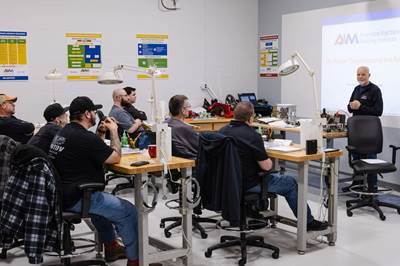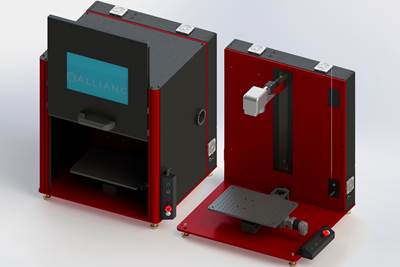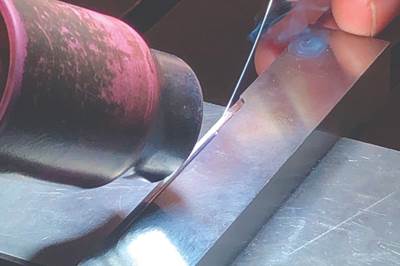ESSENTIAL READING
VIEW ALLHow to Overcome Complex Mold Texturing Problems
Key benefits when considering laser technology for mold texturing and repair.
Read MoreUnderstanding Diamond Compounds
Diamond compounds, with their varied grades, colors and base options, provide a comprehensive solution for mold builders in need of precise and superior polishing across diverse materials and applications.
Read MoreHow to Clean and Maintain Molds With Intricate Conformal Cooling Channels
A water-based, eco-friendly plastic mold cleaning system helps Rankine-Hinman Manufacturing restore flow rates and avoid big-ticket failures on complex and costly molds.
Read MoreQuestions and Considerations Before Sending Your Mold Out for Service
Communication is essential for proper polishing, hot runner manifold cleaning, mold repair, laser engraving and laser welding services.
Read MoreMold Maintenance Continues to Matter: Enhanced Training Program in a New Facility
I attended a MoldTrax mold maintenance workshop in 2019 and shared my experiences, and despite changes in ownership, the workshop's remarkable value endures, as discussed in a recent Q&A with the current leadership.
Read MoreHands-on Workshop Teaches Mold Maintenance Process
Intensive workshop teaches the process of mold maintenance to help put an end to the firefighting culture of many toolrooms.
Read MoreLatest Surface Treatment News And Updates
CO2 Cleaning Effectively Generates Contamination-Free Mold Surfaces
NPE2024: Cool Clean Technologies offers dry ice blasting and CO2 snow cleaning methods for more sustainable, no-touch surface preparation and plastics deburring.
Read MoreQuestions and Considerations Before Sending Your Mold Out for Service
Communication is essential for proper polishing, hot runner manifold cleaning, mold repair, laser engraving and laser welding services.
Read MoreOne-Stop Shop Simplifies Custom Surface Textures, Mold Performance
NPE2024: Standex Engraving Mold-Tech specializes in managing every step of the project process, from texture design and engraving to preparing the tool for production.
Read MoreReasons to Use Fiber Lasers for Mold Cleaning
Fiber lasers offer a simplicity, speed, control and portability, minimizing mold cleaning risks.
Read MoreLaser Engraving System Features MOPA Fiber Laser
NPE2024: The Advantage from Alliance Specialties and Laser Sales is a laser engraving system with a compact footprint, featuring a MOPA fiber laser.
Read MoreMold Maintenance Continues to Matter: Enhanced Training Program in a New Facility
I attended a MoldTrax mold maintenance workshop in 2019 and shared my experiences, and despite changes in ownership, the workshop's remarkable value endures, as discussed in a recent Q&A with the current leadership.
Read MoreFeatured Posts
Hands-on Workshop Teaches Mold Maintenance Process
Intensive workshop teaches the process of mold maintenance to help put an end to the firefighting culture of many toolrooms.
Read MoreHow to Use Simulation to Achieve a High-Gloss Surface Finish
Combining simulation, conformal cooling, and a rapid heat and cooling process can predict and produce the required surface finish for high-gloss plastic parts.
Read MoreVIDEO: Consulting How and When to Use Laser Technology
Wisconsin Engraving President Pete Kambouris and Sales and Marketing Manager Jon Carlson share the benefits of using their laser technology expertise to alleviate customer bottlenecks.
WatchTechnology and Sourcing Guide 2023: Mold Maintenance, Repair & Surface Treatment
A proactive maintenance plan to properly treat a mold to keep it running will decrease repair costs. Proper treatment of the mold’s surface is key to quality, corrosion-resistance, wear and tool life.
Read MoreMMT Chats: SPE MTD 2023 Mold Repair Person of the Year
MoldMaking Technology Editorial Director Christina Fuges sits down with the newly named SPE Mold Technologies Division 2023 Mold Repair Person of the Year to learn about his passion for mold repair. This episode is brought to you by ISCAR with New Ideas for Machining Intelligently.
WatchVIDEO: Insights and Best Practices for Mold Care
Slide Products President Michael Muth shares the products and practices he believes have helped the moldmaking industry the most when it comes to caring for molds.
WatchFAQ: Surface Treatment
How do you polish aluminum?
Buffing occurs in two steps. First, a hard felt buff is impregnated with three-micron diamond until the bottom glistens black. Then some denatured alcohol is squirted onto the aluminum. With the bottom of the buff only - never use the sides of a felt buff, as this guarantees that deep scratches will be cut into the finish - press down only hard enough to buff smooth the entire surface. This hard buffing will erase any imperfections in the surface such as remaining stone marks or brush marks. This microlapping will even help fix mistakes in flatness depending upon the skill of the polisher.
Once you achieve as fine a finish as possible, step two - soft buffing - can begin. At this point the polisher is no longer polishing, but only adding depth and gloss to the liquid black micro finish. The bottom of a soft buff is impregnated with three- or one-micron diamond until the bottom glistens just like the hard buff. Again, only use denatured alcohol as the lubricant and buff out the finish until it is as fine as possible. Anyone who stubbornly buffs with mineral spirits and has gotten to this point has just realized they've got a mess on their hands which can only be solved by more buffing, Don't overwork the surface and never brush or buff with anything other than denatured alcohol and you'll save yourself a lot of trouble at the end.
Once you have lightened up on your downwards hand pressure until the soft buff finish is as fine as possible, it is then time for the final step of rubbing the finish out by hand, which removes all traces of buff marks.
Source: How to Optically Polish Aluminum
How can moldmakers design for maintenance?
Here are some design for maintenance tips for your consideration:
Tip #1: Consider the material being used to build a given tool. When choosing this material, first ask the question: What is the expected life of the product? For mold classification purposes, we can say a “Class 101 mold,” but for the investment, just like our vehicles, we want them to last. I compare one million cycles on a mold to 100,000 miles on a vehicle. In the early days, one million cycles or 100,000 miles was a lot, but not anymore. We expect our tool to exceed one million cycles and our vehicle to exceed 100,000 miles; therefore they should be designed accordingly.
Another material question to ask is: What resin are you running and is it abrasive or corrosive? Some materials are harsh and require extremely hard or exotic steels. There is a big difference in tool wear rate on a simple open/shut tool with no action versus a tool that has moving components. When considering those moving parts, material selection is critical. Corrosion can come in the form of water contact, acidic materials and outgassing. Choosing materials that can stand up against these elements is critical for achieving long tool life.
Tip #2: Include front-loading components as much as possible. Disassembling the whole tool is extremely time consuming. For this reason, we attach the fixed components on the parting line side rather than the backside when we can. In the accompanying images, you can see a simple representation of this in action. Cavity blocks bolted from the front; inserts that can be pulled from the front; hot runner gate tips that can be cleaned in the press; angle pins that can easily be removed; and venting with removable vent dumps are all design elements that will reduce the time to do PM.
Tip #3: Standardization of mold components is a great area to focus on. Components that can be easily standardized include springs, switches, angle pins, angle bushings and shot counters. Keeping the required variety of such parts at a minimum helps the PM shop keep less inventory.
Often, we find ourselves building several molds for the same customer. If you are able to standardize across multiple tooling projects and also use off-the-shelf components, sourcing becomes easier and lead times can be dramatically reduced. In many cases, skilled moldmakers are able to order stock blank components and finish them in-house with the detail needed, whether it be cutting them to length or adding other details.
Source: Design Your Tools for Moldability... and Maintenance
































